Enforcing Civil Rights Legislation During Reconstruction
Making Connections
All documents and text associated with this activity are printed below, followed by a worksheet for student responses.Introduction
On December 1st, 1873 — the first day of the 43rd Congress — Sen. Charles Sumner introduced a bill that would eventually become the Civil Rights Act of 1875. From this date until March 1883, the contents of the bill would be endlessly disputed. The debate over this bill, its passage into law, and its eventual nullification, represent the complexities of the Reconstruction Era. By tracing the life of this bill, we see the hopes, fears, frustrations, and turmoil of Reconstruction and the difficulty of reconciling the competing factions in the post-Civil War United States.This activity will have you examine not just what happened during Reconstruction, but how Reconstruction efforts unfolded. Examining this process will illuminate how our government operates, how the Legislative and Judicial branches of our federal government aided in the expansion and contraction of civil rights, and how individual citizens navigated this chaotic era.
For tonight's homework, only read the first document — "Sumner Civil Rights Bill" — and its accompanying activity. We will complete the remainder of the activity in class tomorrow.
Name:
Class:
Class:
Worksheet
Enforcing Civil Rights Legislation During Reconstruction
Making Connections
Examine the documents and text included in this activity. Fill in any blanks in the sequence with your thoughts and write your conclusion response in the space provided.As you read the document and after you reflect on it, complete the analysis worksheet I gave you in class.
Once you finish the worksheet for homework, you may stop working on the assignment. We will resume the activity in class tomorrow.
Once you finish the worksheet for homework, you may stop working on the assignment. We will resume the activity in class tomorrow.
Sumner Civil Rights Bill
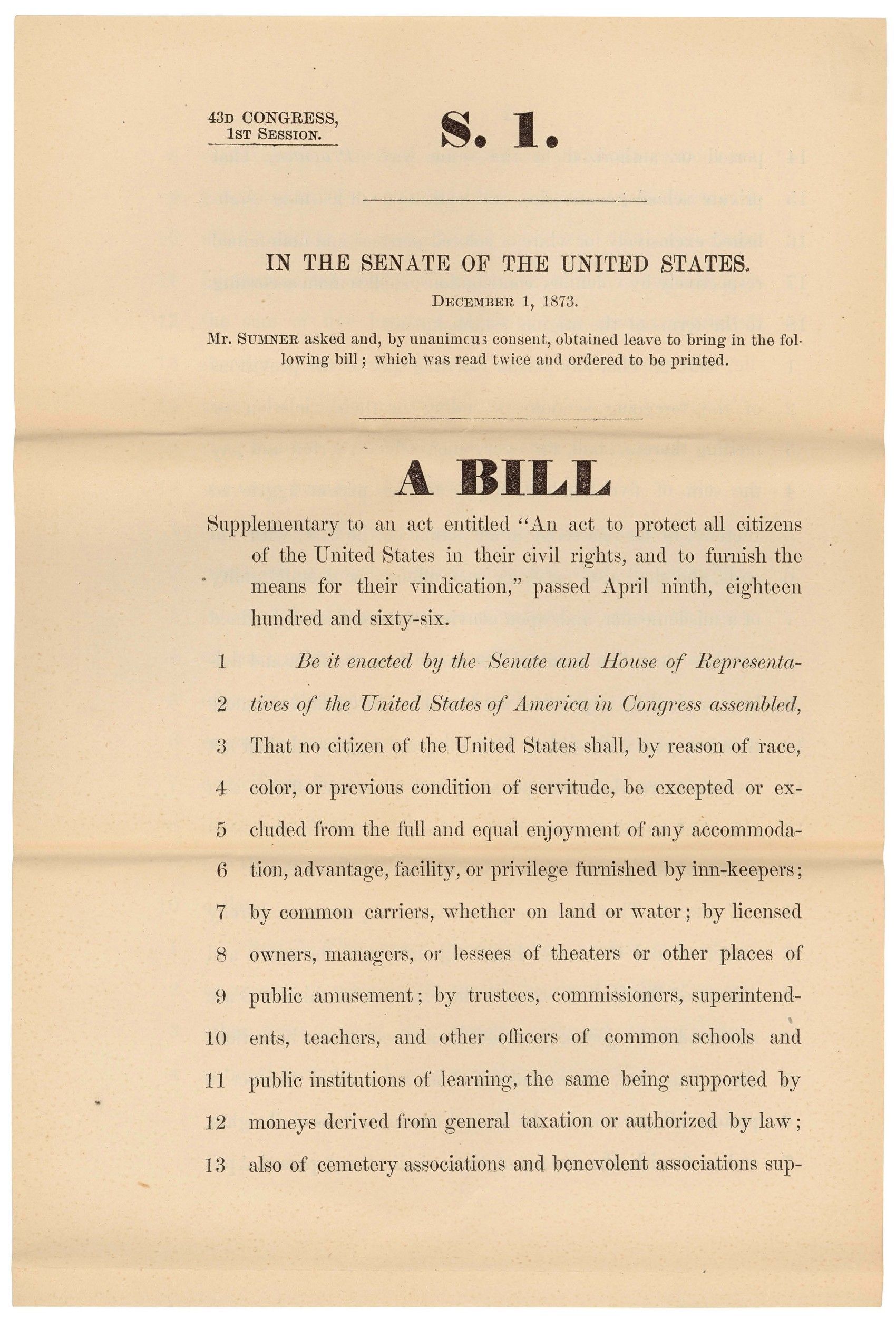
Sumner Civil Rights Bill
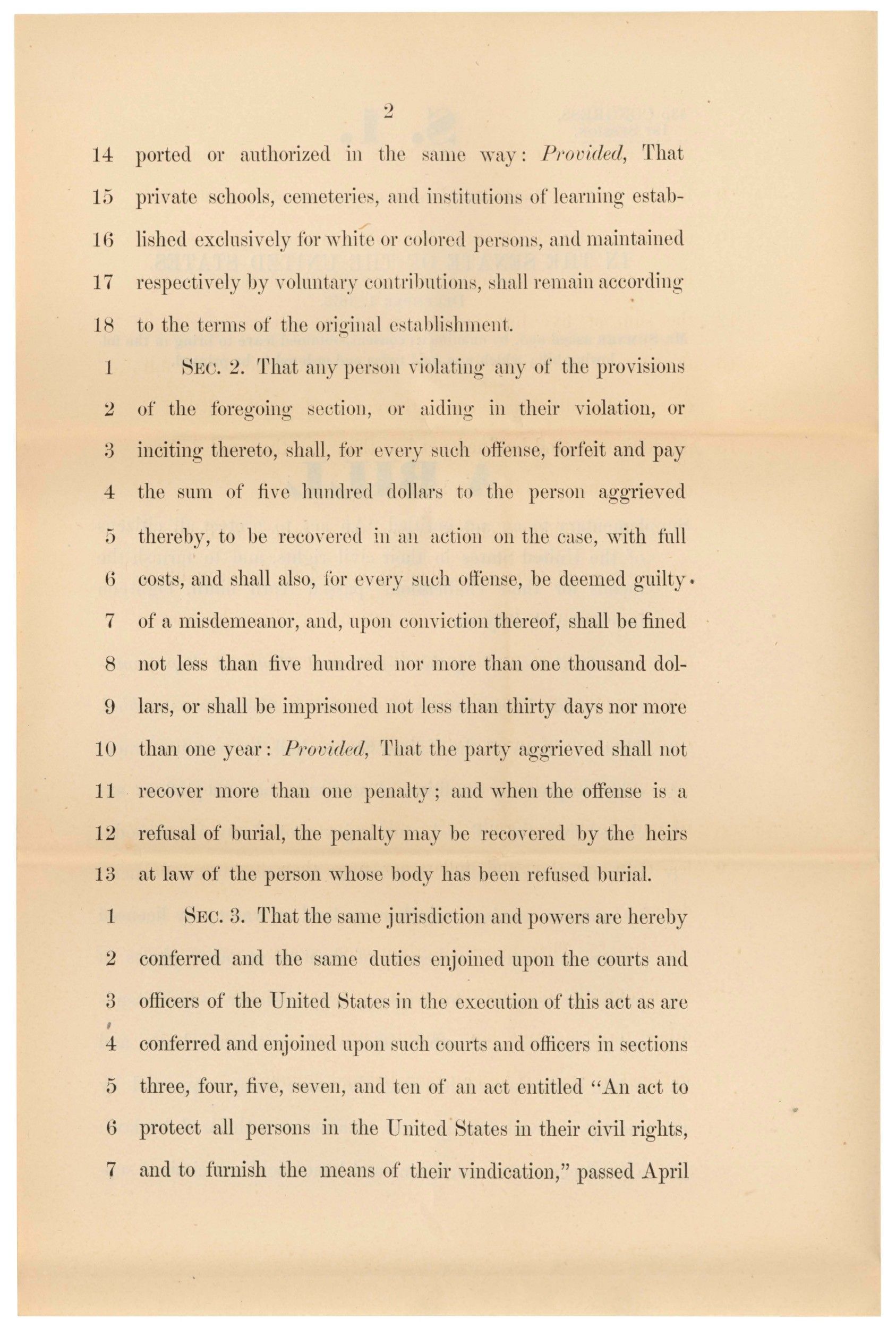
Sumner Civil Rights Bill
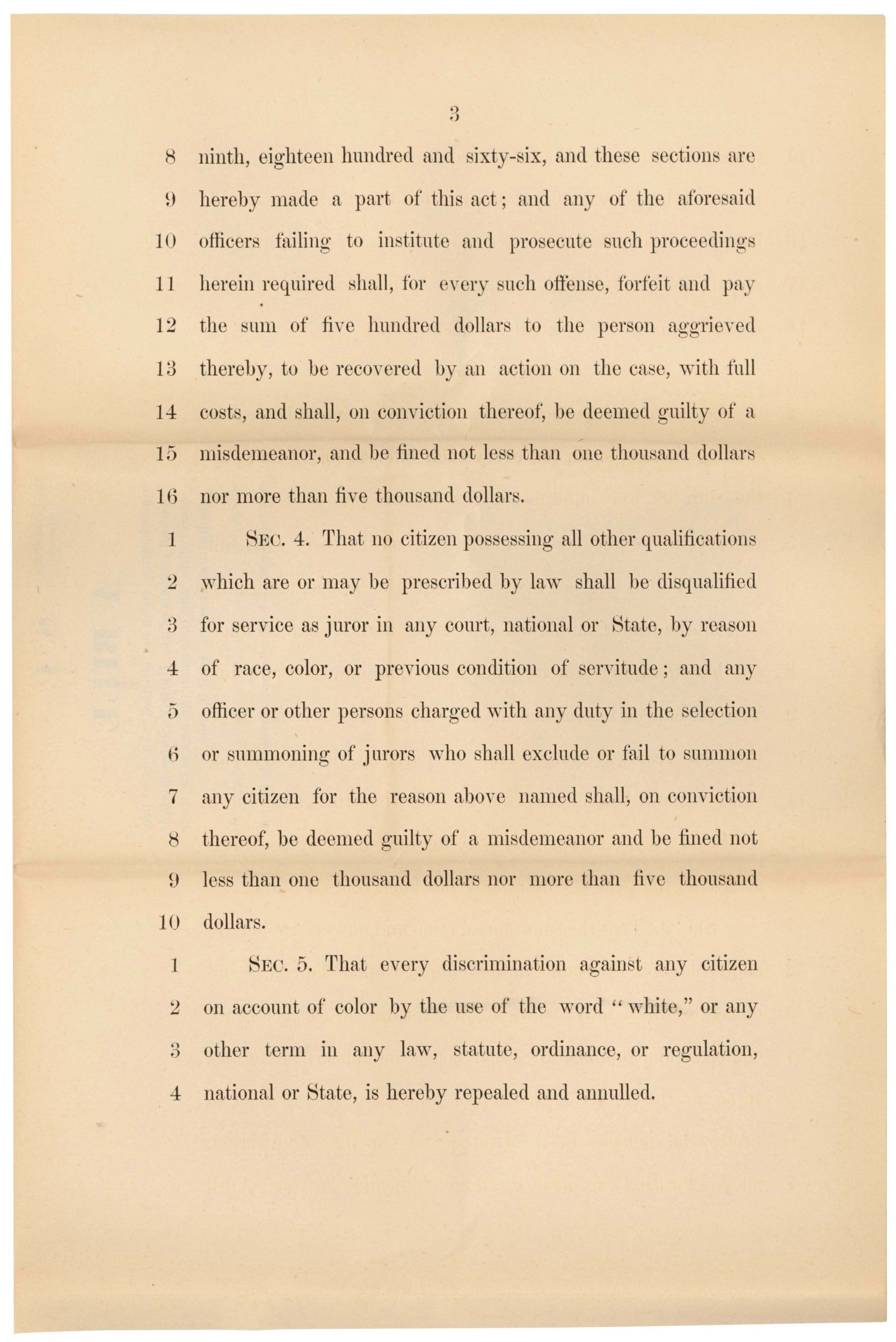
Look at the map and picture of the Bingham House (a hotel in Philadelphia). First, locate the Bingham House on the map (click on the image and then open it with a right click to see more detail). Then, look at the next map, which has labels that represent the city’s current landmarks. This will give you a better idea of where the Bingham House was.
1875 Map of Philadelphia from the Greater Philadelphia GeoHistory Network and Photograph of the Bingham House. Sources: City Atlas of Philadelphia, Vol. 6, Wards 2 through 20, 29 and 31: Plate H, by G. M. Hopkins, 1875, available from the Greater Philadelphia GeoHistory Network at http://www.philageohistory.org/rdic-images/view-image.cfm/GMH1875v6-plate_H AND Bingham House Philada., Photographers Bartlett & Smith, ca. 1869, available at https://digital.librarycompany.org/islandora/object/digitool%3A101113 (Right click the image and open it to see more detail.)
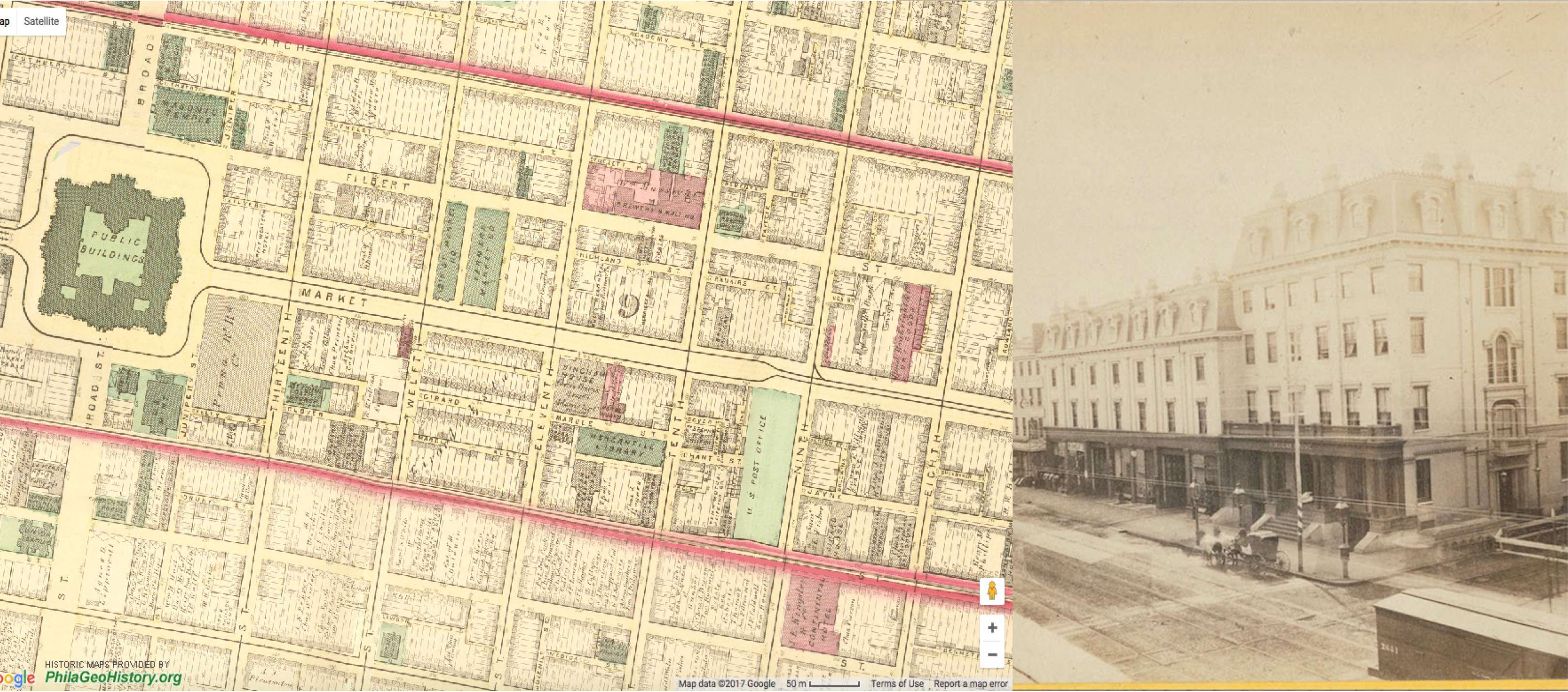
1875 Map of Philadelphia with Contemporary Labels, from the Greater Philadelphia GeoHistory Network. Source: City Atlas of Philadelphia, Vol. 6, Wards 2 through 20, 29 and 31: Plate H, by G. M. Hopkins, 1875, seen at http://www.philageohistory.org/tiles/viewer/ (Right click the image and open it to see more detail.)
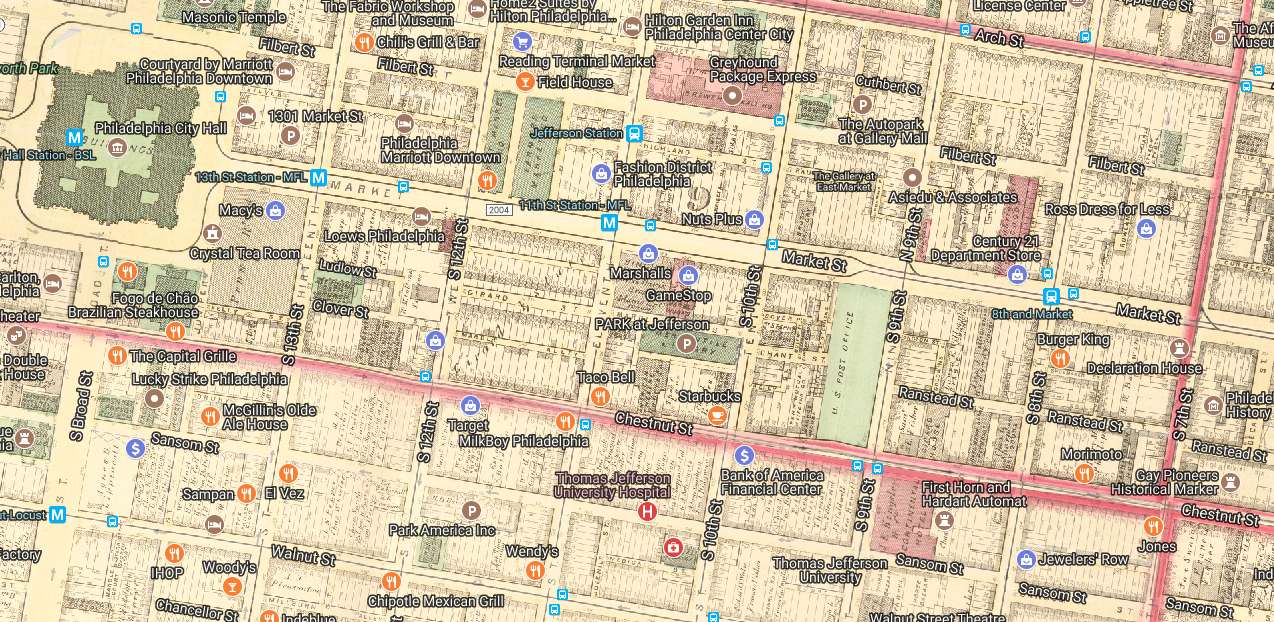
Warm Up Question
According to Sumner’s proposed bill, would African Americans be allowed to stay in this facility? Your answer must include a quote from his proposed bill.
If yes, what was the penalty for not allowing African Americans access to this facility?
According to Sumner’s proposed bill, would African Americans be allowed to stay in this facility? Your answer must include a quote from his proposed bill.
If yes, what was the penalty for not allowing African Americans access to this facility?
Enter your response
In 1875, the Bingham House was the setting for a civil rights battle. First, read the newspaper clipping to learn more about the event. Then, provide a brief summary of what happened. Finally, based on the legislation you read yesterday and your knowledge of the socio-political climate of Reconstruction, provide an educated guess as to what the outcome of the ensuing court case was (the article has been edited by removing the ending).
"Civil RIghts" page 1, The New York Observer
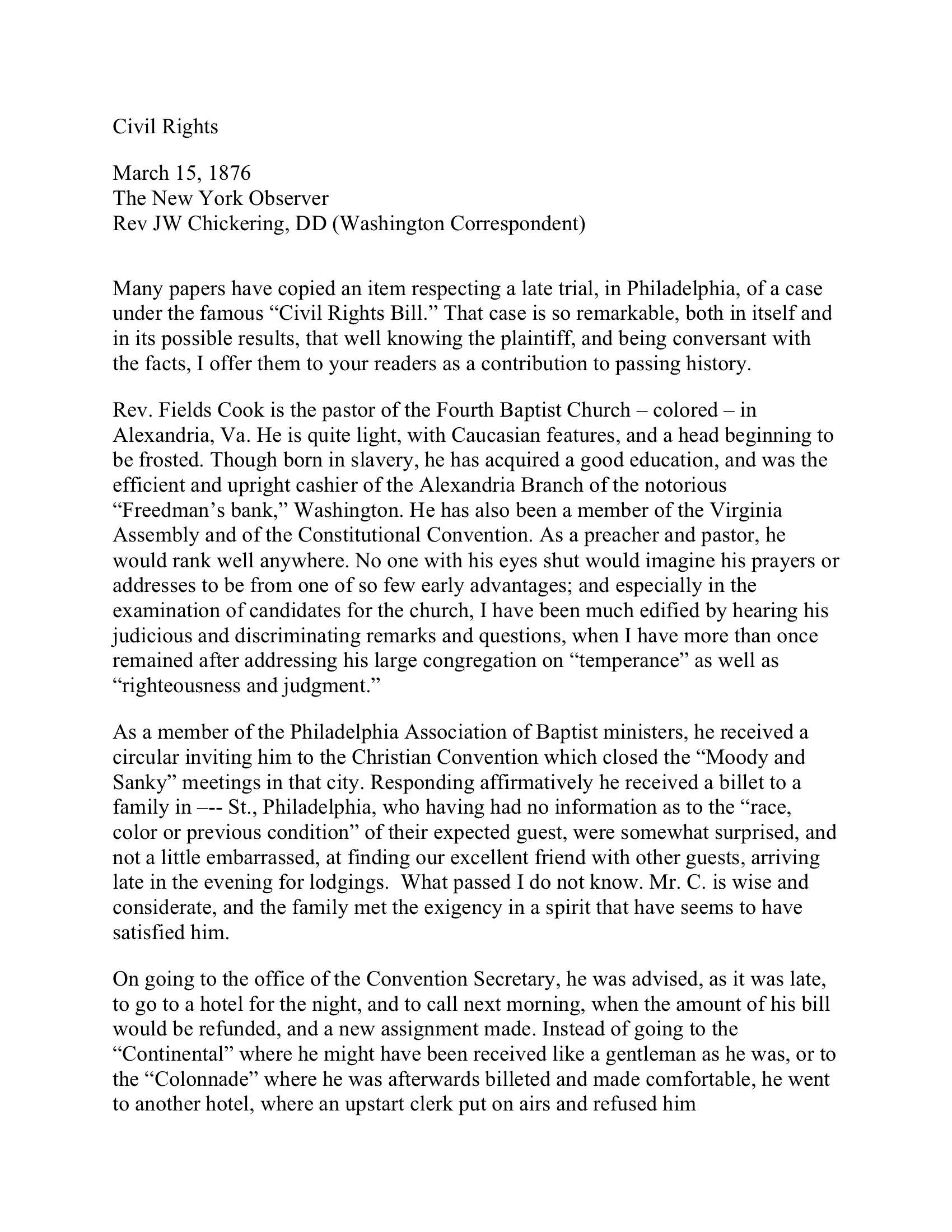
"Civil RIghts" page 2, The New York Observer
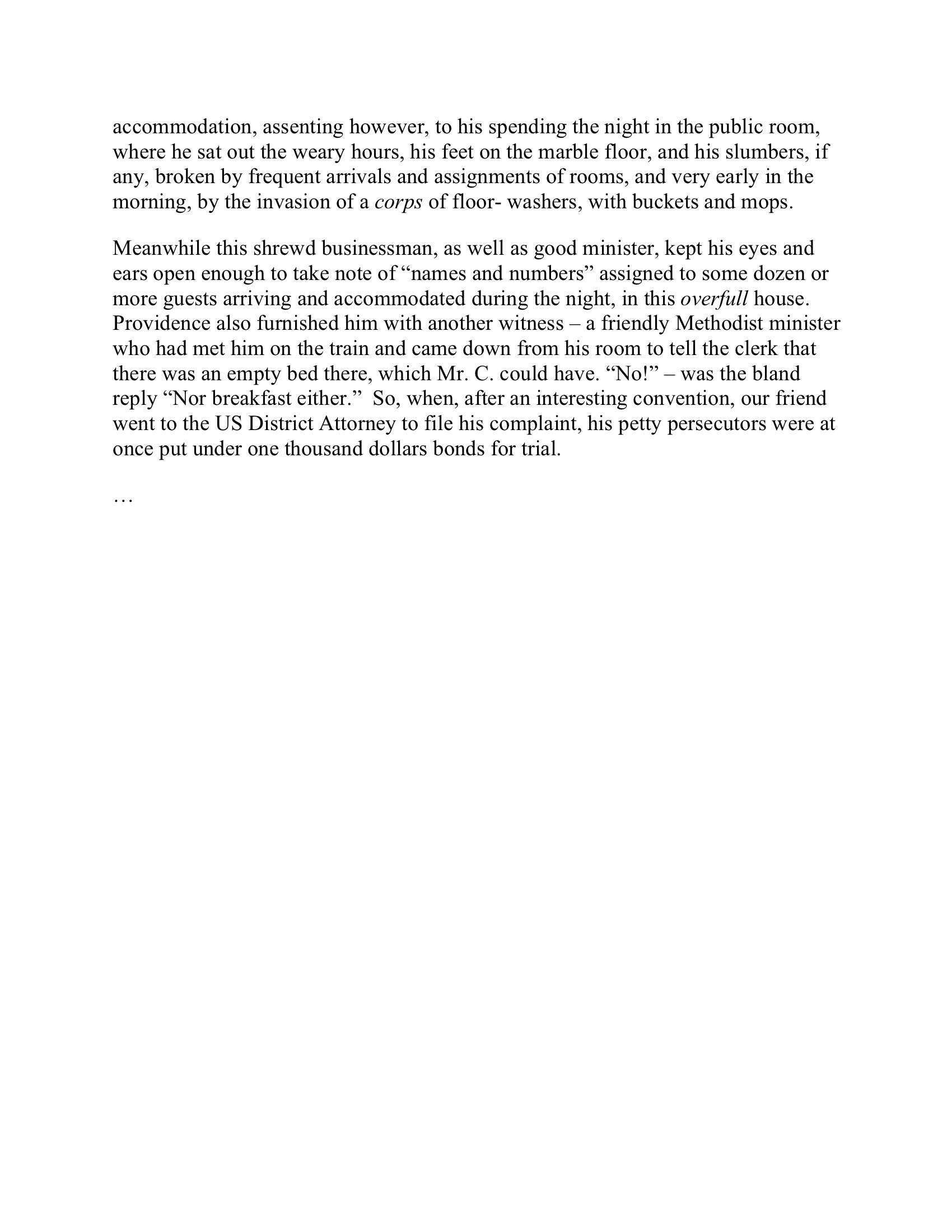
Enter your response
Discussion
Read the following court document which indicates whether Newcomer was innocent or guilty of violating Fields Cook's civil rights according to the Civil Rights Act of 1875.
Then, refer back to the Philadelphia map with the modern labels. Do you think the court should have come to this conclusion?
Read the following court document which indicates whether Newcomer was innocent or guilty of violating Fields Cook's civil rights according to the Civil Rights Act of 1875.
Then, refer back to the Philadelphia map with the modern labels. Do you think the court should have come to this conclusion?
United States v. Newcomer Verdict Overview, National Archives

In 1883, the Supreme Court heard a collection of civil rights cases, called the Civil Rights Cases, all of which involved plaintiffs who claimed the defendants violated the Civil Rights Act of 1875 by denying them access to public facilities due to their race. In this case, the Supreme Court considered the defendants’ guilt by determining whether or not the Civil Rights Act of 1875 was actually constitutional. In essence, the question the Supreme Court set out to answer was: does Congress have the power to regulate the actions of private citizens with regard to civil rights? Read through the opinion of the court with a partner. As you do so, select three quotes that explain and express the Supreme Court’s decision. After each quote, provide a one-sentence summary of what the document is communicating.
Civil Rights Cases Court Opinion, page 1, Cornell University Law School's Legal Information Institute

Civil Rights Cases Court Opinion, page 2, Cornell University Law School's Legal Information Institute

Civil Rights Cases Court Opinion, page 3, Cornell University Law School's Legal Information Institute

Enter your response
1
Activity Element
Sumner Civil Rights Bill
Page 1

2
Activity Element
Sumner Civil Rights Bill
Page 2

3
Activity Element
Sumner Civil Rights Bill
Page 3

4
Activity Element
1875 Map of Philadelphia from the Greater Philadelphia GeoHistory Network and Photograph of the Bingham House. Sources: City Atlas of Philadelphia, Vol. 6, Wards 2 through 20, 29 and 31: Plate H, by G. M. Hopkins, 1875, available from the Greater Philadelphia GeoHistory Network at http://www.philageohistory.org/rdic-images/view-image.cfm/GMH1875v6-plate_H AND Bingham House Philada., Photographers Bartlett & Smith, ca. 1869, available at https://digital.librarycompany.org/islandora/object/digitool%3A101113 (Right click the image and open it to see more detail.)

5
Activity Element
1875 Map of Philadelphia with Contemporary Labels, from the Greater Philadelphia GeoHistory Network. Source: City Atlas of Philadelphia, Vol. 6, Wards 2 through 20, 29 and 31: Plate H, by G. M. Hopkins, 1875, seen at http://www.philageohistory.org/tiles/viewer/ (Right click the image and open it to see more detail.)

6
Activity Element
"Civil RIghts" page 1, The New York Observer

7
Activity Element
"Civil RIghts" page 2, The New York Observer

8
Activity Element
United States v. Newcomer Verdict Overview, National Archives

9
Activity Element
Civil Rights Cases Court Opinion, page 1, Cornell University Law School's Legal Information Institute

10
Activity Element
Civil Rights Cases Court Opinion, page 2, Cornell University Law School's Legal Information Institute

11
Activity Element
Civil Rights Cases Court Opinion, page 3, Cornell University Law School's Legal Information Institute

Conclusion
Enforcing Civil Rights Legislation During Reconstruction
Making Connections
For homework, respond to the following question in a paragraph:How do the three events you investigated — the passage of the Civil Rights Act of 1875, Fields Cook's push for equality, and the Supreme Court's decision in the Civil Rights Cases — represent the successes and failures of the Reconstruction Era?
Your Response
Document
Sumner Civil Rights Bill
12/1/1873
There was a great divide over how far the Government should go to enforce the rights established by the 14th and 15th Amendments. The Civil Right Act of 1875, first proposed by Senator Charles Sumner in 1870, was an attempt to codify those rights.
Senator Sumner was the chief Radical Republican leader during Reconstruction and a vocal proponent of civil rights for freedmen. He introduced the version shown here to the Senate in 1873. It proposed to prohibit racial discrimination in public accommodations, such as hotels, theaters, transportation, and schools. He was so determined to see it pass that on his deathbed in 1874 he begged Frederick Douglass not to let it fail.
The bill that passed after much debate and revision in 1875 stated that all American citizens “shall be entitled to the full and equal enjoyment of the accommodations, advantages, facilities, and privileges of inns, public conveyances on land or water, theaters, and other places of public amusement.” Prior to passage, Congress removed the clause which prohibited discrimination in public schools.
Senator Sumner was the chief Radical Republican leader during Reconstruction and a vocal proponent of civil rights for freedmen. He introduced the version shown here to the Senate in 1873. It proposed to prohibit racial discrimination in public accommodations, such as hotels, theaters, transportation, and schools. He was so determined to see it pass that on his deathbed in 1874 he begged Frederick Douglass not to let it fail.
The bill that passed after much debate and revision in 1875 stated that all American citizens “shall be entitled to the full and equal enjoyment of the accommodations, advantages, facilities, and privileges of inns, public conveyances on land or water, theaters, and other places of public amusement.” Prior to passage, Congress removed the clause which prohibited discrimination in public schools.
Sumner, who died in 1874, did not live to celebrate the bill’s passage. Nor did he see its ultimate failure when, in 1883, the U.S. Supreme Court ruled the Civil Rights Act of 1875 unconstitutional.
This primary source comes from the Records of the U.S. House of Representatives.
National Archives Identifier: 1986640
Full Citation: Sumner Civil Rights Bill; 12/1/1873; (HR43A-C1); Bills and Resolutions Originating in the Senate and Considered in the House, 1789 - 2003; Records of the U.S. House of Representatives, ; National Archives Building, Washington, DC. [Online Version, https://www.docsteach.org/documents/document/sumner-civil-rights-bill, April 24, 2024]Sumner Civil Rights Bill
Page 1
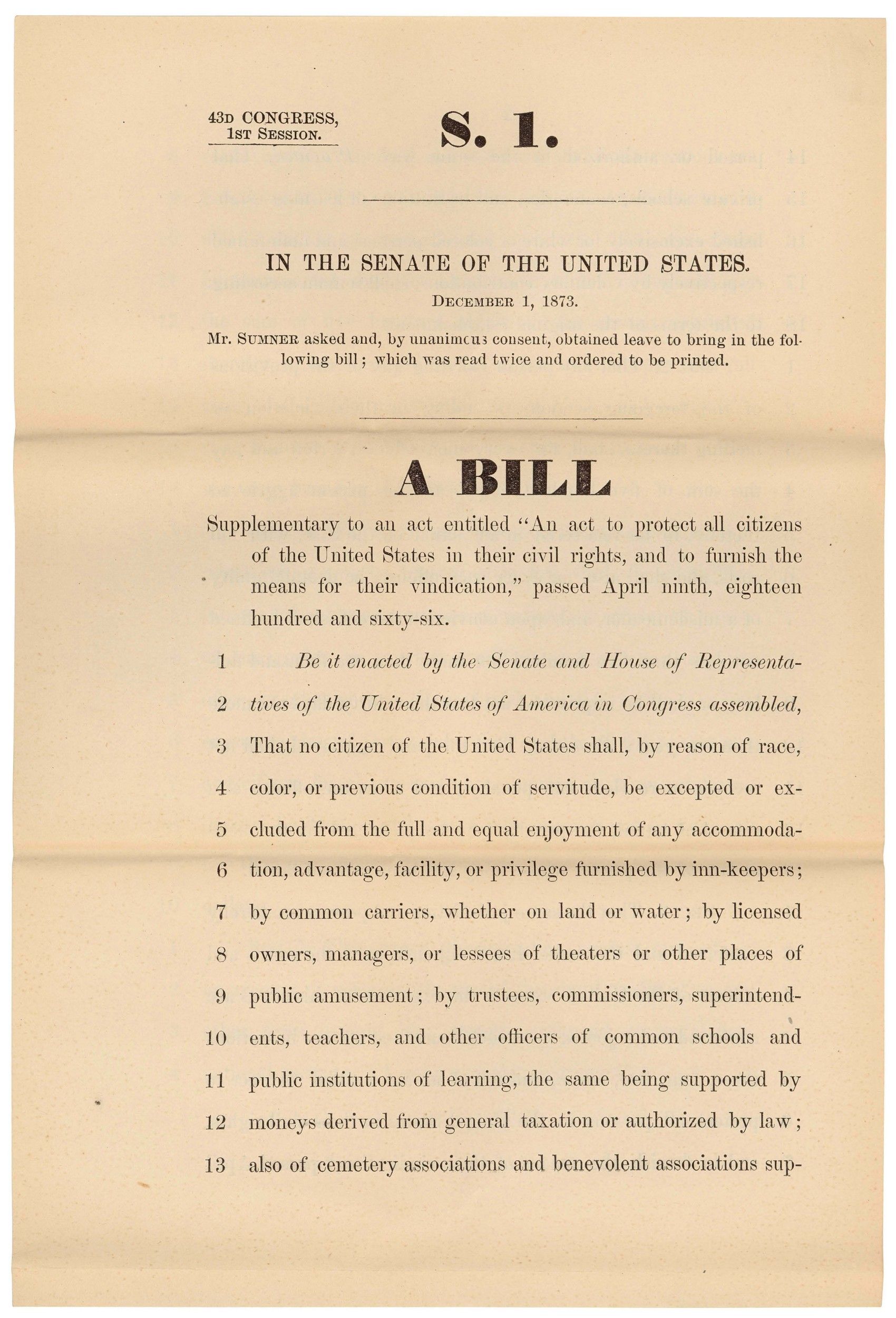
Sumner Civil Rights Bill
Page 2
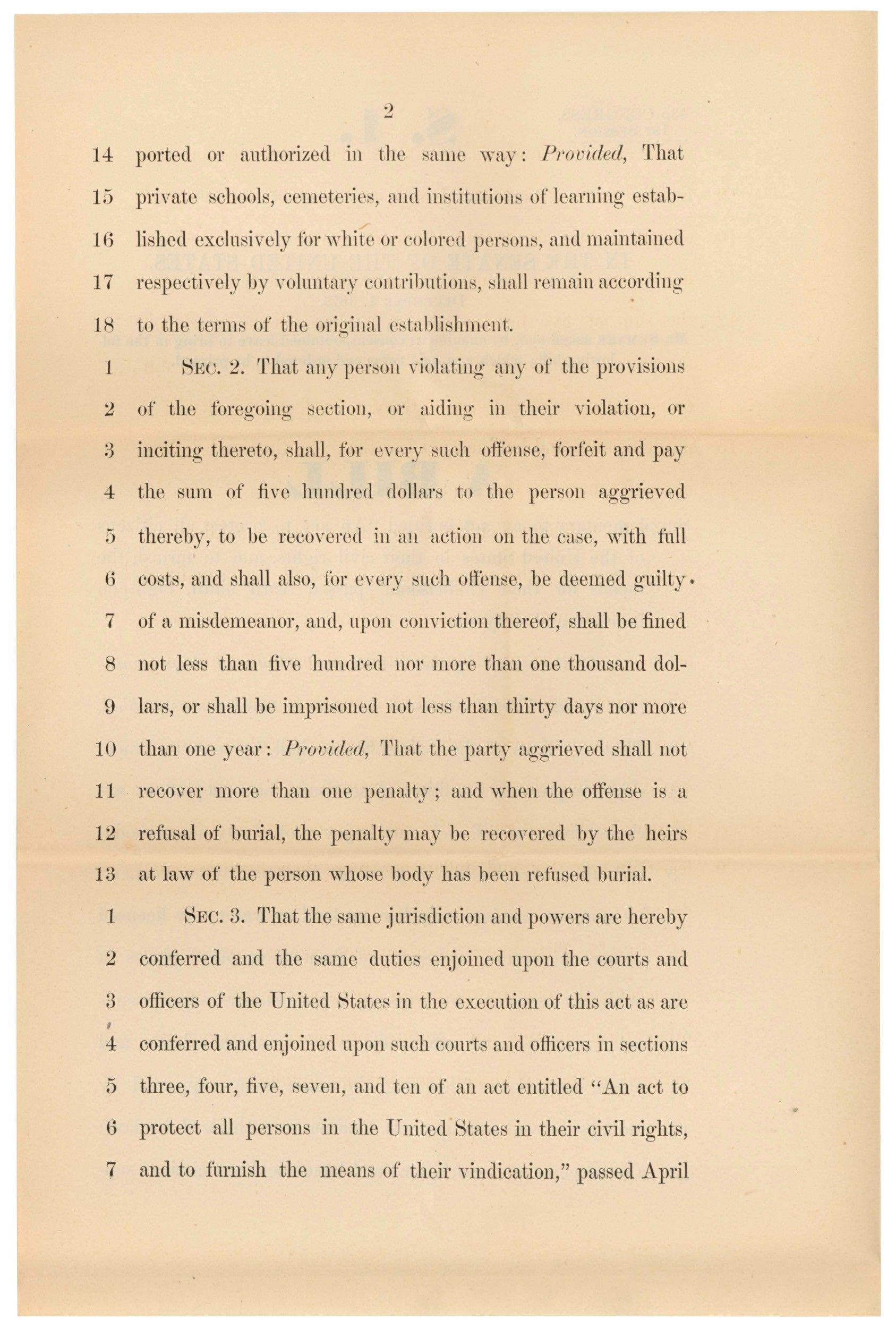
Sumner Civil Rights Bill
Page 3

Document
Sumner Civil Rights Bill
12/1/1873
There was a great divide over how far the Government should go to enforce the rights established by the 14th and 15th Amendments. The Civil Right Act of 1875, first proposed by Senator Charles Sumner in 1870, was an attempt to codify those rights.
Senator Sumner was the chief Radical Republican leader during Reconstruction and a vocal proponent of civil rights for freedmen. He introduced the version shown here to the Senate in 1873. It proposed to prohibit racial discrimination in public accommodations, such as hotels, theaters, transportation, and schools. He was so determined to see it pass that on his deathbed in 1874 he begged Frederick Douglass not to let it fail.
The bill that passed after much debate and revision in 1875 stated that all American citizens “shall be entitled to the full and equal enjoyment of the accommodations, advantages, facilities, and privileges of inns, public conveyances on land or water, theaters, and other places of public amusement.” Prior to passage, Congress removed the clause which prohibited discrimination in public schools.
Senator Sumner was the chief Radical Republican leader during Reconstruction and a vocal proponent of civil rights for freedmen. He introduced the version shown here to the Senate in 1873. It proposed to prohibit racial discrimination in public accommodations, such as hotels, theaters, transportation, and schools. He was so determined to see it pass that on his deathbed in 1874 he begged Frederick Douglass not to let it fail.
The bill that passed after much debate and revision in 1875 stated that all American citizens “shall be entitled to the full and equal enjoyment of the accommodations, advantages, facilities, and privileges of inns, public conveyances on land or water, theaters, and other places of public amusement.” Prior to passage, Congress removed the clause which prohibited discrimination in public schools.
Sumner, who died in 1874, did not live to celebrate the bill’s passage. Nor did he see its ultimate failure when, in 1883, the U.S. Supreme Court ruled the Civil Rights Act of 1875 unconstitutional.
This primary source comes from the Records of the U.S. House of Representatives.
National Archives Identifier: 1986640
Full Citation: Sumner Civil Rights Bill; 12/1/1873; (HR43A-C1); Bills and Resolutions Originating in the Senate and Considered in the House, 1789 - 2003; Records of the U.S. House of Representatives, ; National Archives Building, Washington, DC. [Online Version, https://www.docsteach.org/documents/document/sumner-civil-rights-bill, April 24, 2024]Sumner Civil Rights Bill
Page 1

Sumner Civil Rights Bill
Page 2

Sumner Civil Rights Bill
Page 3

Document
Sumner Civil Rights Bill
12/1/1873
There was a great divide over how far the Government should go to enforce the rights established by the 14th and 15th Amendments. The Civil Right Act of 1875, first proposed by Senator Charles Sumner in 1870, was an attempt to codify those rights.
Senator Sumner was the chief Radical Republican leader during Reconstruction and a vocal proponent of civil rights for freedmen. He introduced the version shown here to the Senate in 1873. It proposed to prohibit racial discrimination in public accommodations, such as hotels, theaters, transportation, and schools. He was so determined to see it pass that on his deathbed in 1874 he begged Frederick Douglass not to let it fail.
The bill that passed after much debate and revision in 1875 stated that all American citizens “shall be entitled to the full and equal enjoyment of the accommodations, advantages, facilities, and privileges of inns, public conveyances on land or water, theaters, and other places of public amusement.” Prior to passage, Congress removed the clause which prohibited discrimination in public schools.
Senator Sumner was the chief Radical Republican leader during Reconstruction and a vocal proponent of civil rights for freedmen. He introduced the version shown here to the Senate in 1873. It proposed to prohibit racial discrimination in public accommodations, such as hotels, theaters, transportation, and schools. He was so determined to see it pass that on his deathbed in 1874 he begged Frederick Douglass not to let it fail.
The bill that passed after much debate and revision in 1875 stated that all American citizens “shall be entitled to the full and equal enjoyment of the accommodations, advantages, facilities, and privileges of inns, public conveyances on land or water, theaters, and other places of public amusement.” Prior to passage, Congress removed the clause which prohibited discrimination in public schools.
Sumner, who died in 1874, did not live to celebrate the bill’s passage. Nor did he see its ultimate failure when, in 1883, the U.S. Supreme Court ruled the Civil Rights Act of 1875 unconstitutional.
This primary source comes from the Records of the U.S. House of Representatives.
National Archives Identifier: 1986640
Full Citation: Sumner Civil Rights Bill; 12/1/1873; (HR43A-C1); Bills and Resolutions Originating in the Senate and Considered in the House, 1789 - 2003; Records of the U.S. House of Representatives, ; National Archives Building, Washington, DC. [Online Version, https://www.docsteach.org/documents/document/sumner-civil-rights-bill, April 24, 2024]Sumner Civil Rights Bill
Page 1

Sumner Civil Rights Bill
Page 2

Sumner Civil Rights Bill
Page 3

